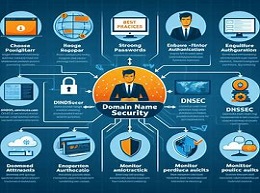
Domain Name Security: Best Practices for Website Protection
In the dynamic landscape of the internet, where every click matters, ensuring the security of your domain name is paramount. This article serves as a comprehensive guide, offering insights and practical advice on implementing best practices to protect your website from potential threats. Let's embark on a journey to fortify your digital presence and keep your domain safe and sound.
1. The Cyber Threat Landscape: Understanding the Risks: Navigating the complex world of online threats.
Explore the diverse array of cyber threats that can compromise the security of your domain. Understand the motivations behind cyber attacks and why vigilance is essential in the digital age.
2. The Foundation: Choosing a Secure Domain Registrar: Selecting a registrar with a strong commitment to security.
Learn the criteria for choosing a secure domain registrar. Real-world examples illustrate the consequences of making an informed versus uninformed choice.
3. Domain Privacy Protection: Shielding Your Identity from Prying Eyes: Exploring the importance of privacy in domain registration.
Delve into the significance of domain privacy protection and its role in shielding your personal information from being exposed. Case studies highlight instances where privacy protection proved critical.
4. Strong Password Policies: The First Line of Defense: Establishing robust password practices for domain security.
Understand the importance of strong password policies and how they serve as the first line of defense against unauthorized access. Practical examples showcase the impact of weak passwords on domain security.
5. Two-Factor Authentication (2FA): Adding an Extra Layer of Defense: Implementing two-factor authentication for enhanced security.
Explore the benefits of two-factor authentication in bolstering domain security. Real-world cases demonstrate how 2FA thwarted unauthorized access attempts.
6. Regular Security Audits: Proactive Measures for Continuous Protection: Conducting routine audits to identify and mitigate vulnerabilities.
Learn the importance of regular security audits in identifying and addressing potential vulnerabilities. Examples showcase businesses that proactively protected their domains through routine assessments.
7. DNS Security: Safeguarding the Core of Your Online Presence: Understanding the role of DNS security in overall domain protection.
Delve into the intricacies of DNS security and its pivotal role in safeguarding the core of your online presence. Case studies illustrate the impact of DNS vulnerabilities on website security.
8. SSL Certificates: Encrypting Communication for Secure Transactions: Deploying SSL certificates to ensure secure data transmission.
Explore the significance of SSL certificates in encrypting communication and securing online transactions. Real-world examples highlight how SSL certificates contribute to a trustworthy online environment.
9. Domain Locking: Adding an Extra Layer of Security: Utilizing domain locking as an additional safeguard.
Understand the concept of domain locking and its role as an extra layer of security. Practical examples showcase instances where domain locking prevented unauthorized transfers.
10. Incident Response Plans: A Strategic Approach to Cybersecurity: Developing a comprehensive incident response plan.
Learn the importance of having an incident response plan in place. Real-world cases demonstrate the effectiveness of strategic planning in mitigating the impact of security incidents.
In the ever-evolving digital realm, domain security is not a luxury – it's a necessity. By incorporating these best practices and learning from real-world examples, you can fortify your digital fortress and protect your website from potential threats. Remember, prevention is the best protection. Safeguard your domain, secure your online presence, and navigate the digital landscape with confidence.